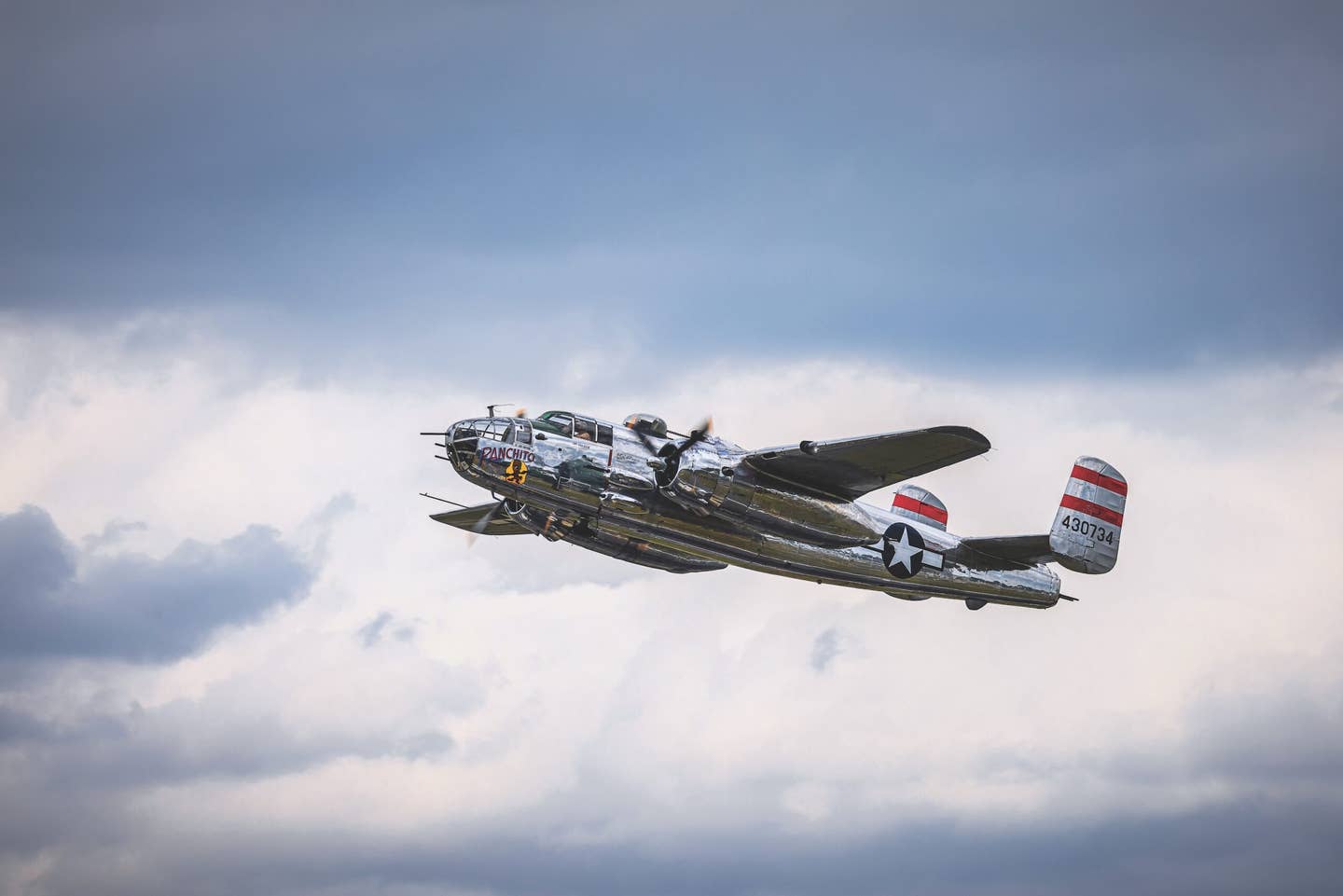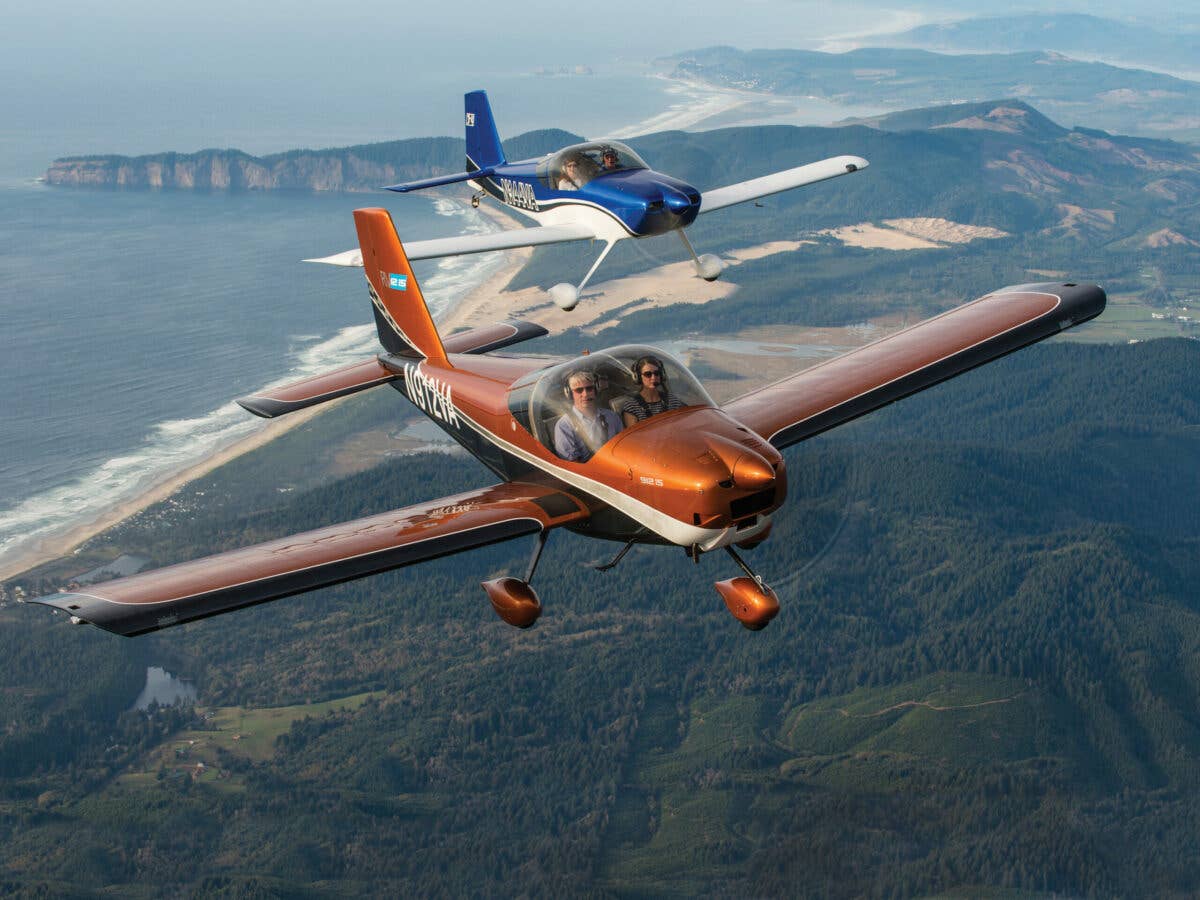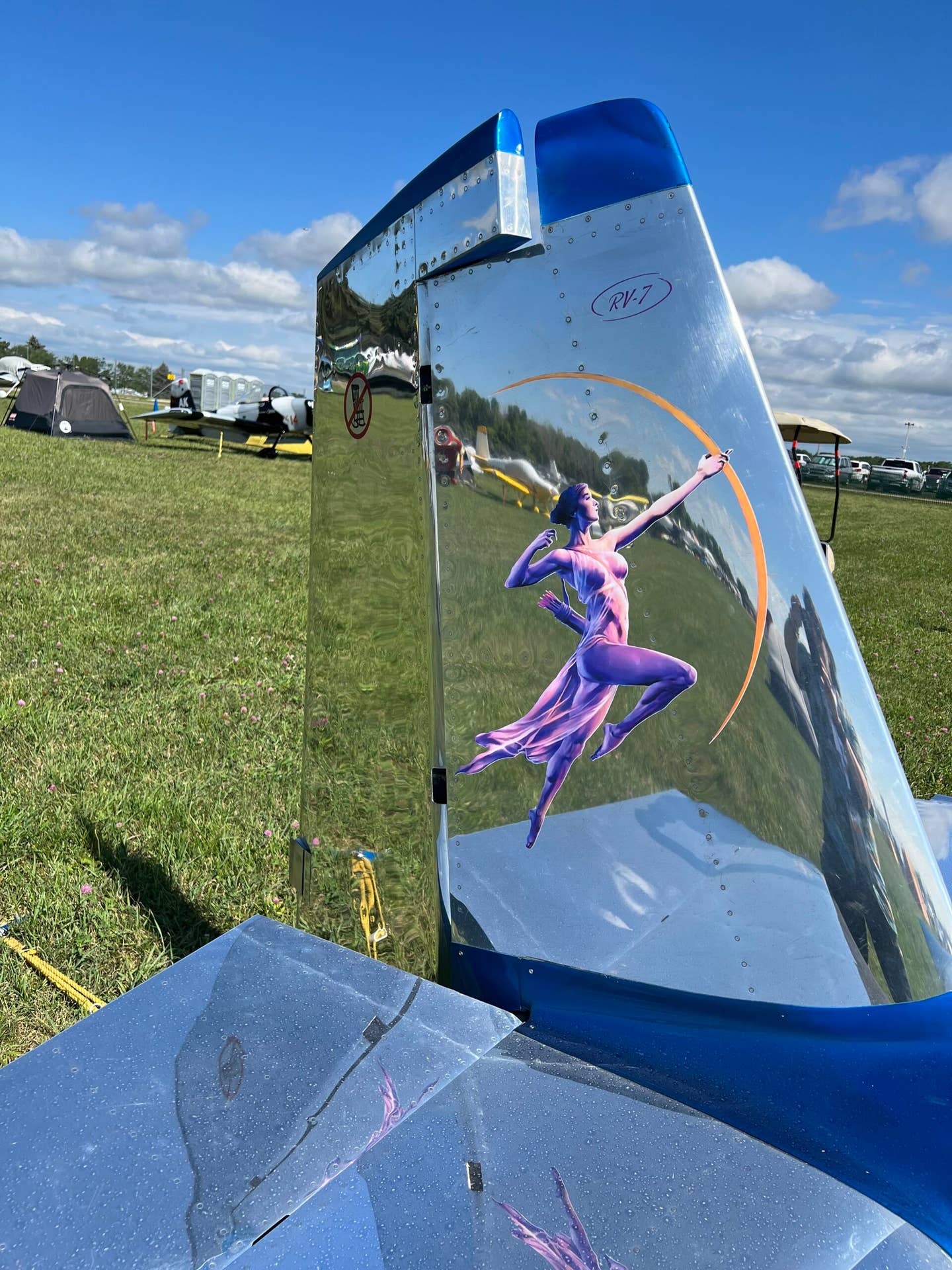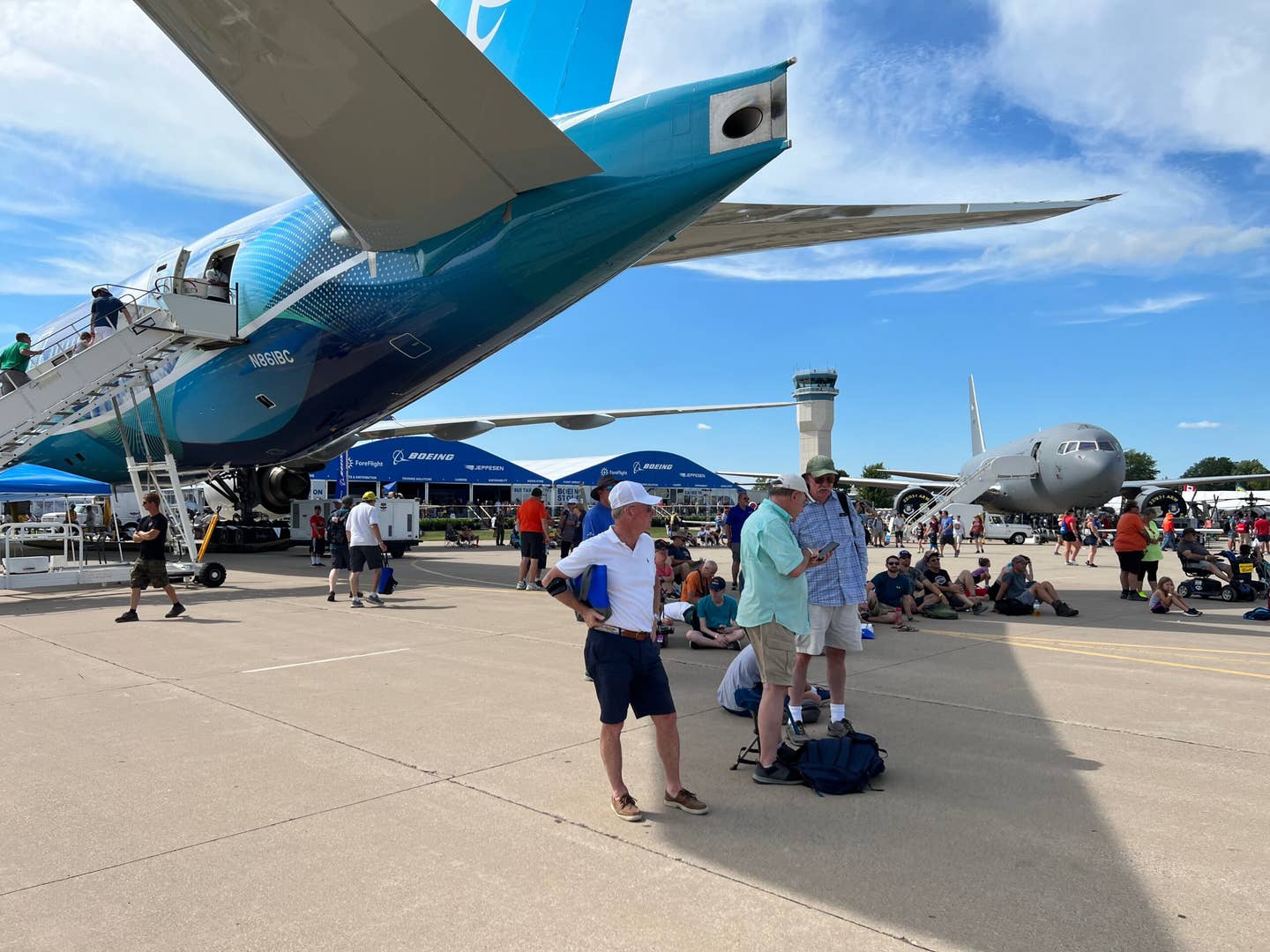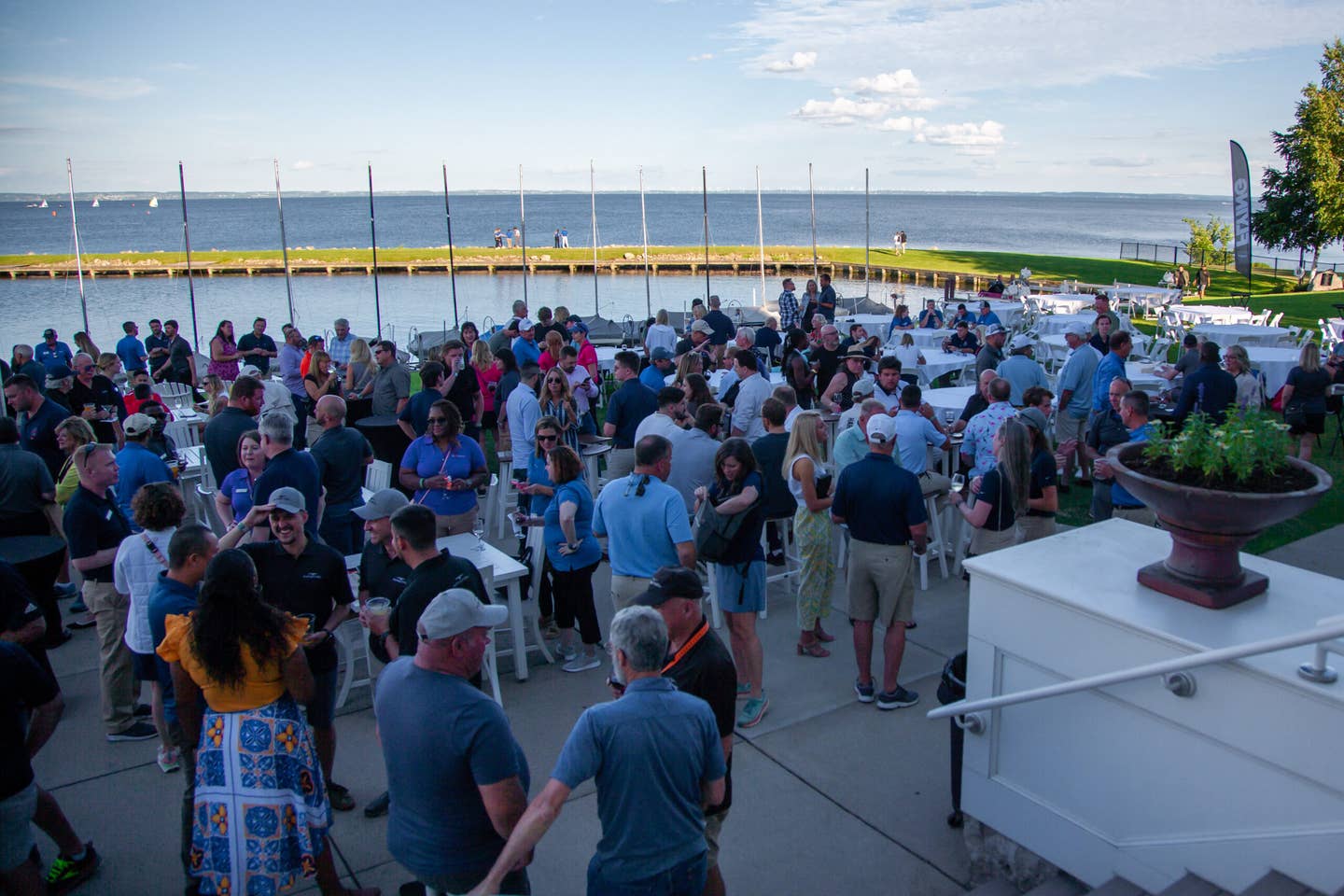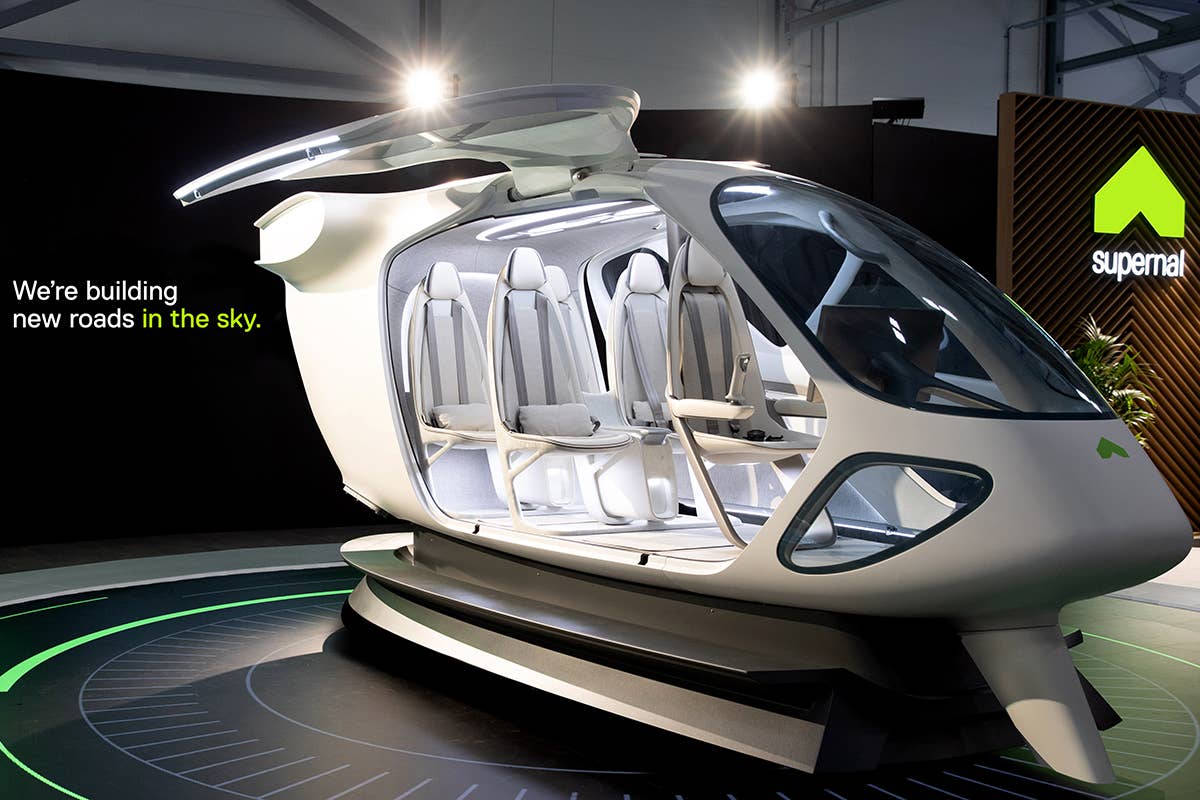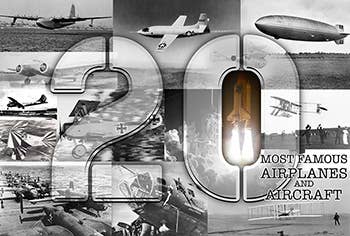
We as pilots love airplane types. Most of us, in fact, have a favorite airplane, be it a Piper Cub or a Lockheed SR-71. There are plane types, and then there are planes. Specific planes. The history of aviation is punctuated with the arrival on the scene, sometimes very publicly and sometimes in top secret, of a very special one-of-a-kind aircraft. From the first plane to ever fly — talk about a one-off design — to airplanes that entered the record books or reshaped the popular imagination, the history of famous individual airplanes in many ways mirrors the history of aviation itself. We proudly present a short list of 20 of the most famous airplanes to ever take wing (or orbit). Some of them have an unbreakable hold in any list of famous planes; with a few of the others, well, we'll let you be the judge. Enjoy the ride.
Memphis Belle was the name of one of the first B-17 bombers to safely complete 25 missions during World War II. The milestone led to a 31-city war bond publicity tour in America during the war and a Hollywood feature film in 1990. A member of the 324th Bomb Squadron, the Memphis Belle flew its first mission on November 7, 1942, and its last on May 19, 1943. Capt. Robert Morgan named the B-17 for Margaret Polk, his sweetheart back home in Tennessee. After the war, the city of Memphis bought the airplane and put it on display outdoors at the National Guard armory near the city's fairgrounds. The effects of the weather and vandals left the Memphis Belle in a sorry state until the airplane was rescued by the Memphis Belle Memorial Association. Today the airplane is undergoing an extensive, 10-year restoration in preparation for its permanent public display at the United States Air Force Museum in Dayton, Ohio.
Suspended at the entrance of the National Air and Space Museum's Stephen F. Udvar-Hazy Center is a red and white Pitts Special named Little Stinker. The oldest surviving Pitts, Little Stinker was the second Pitts airplane built by Curtis Pitts in 1946 and was made famous by Betty Skelton who flew it to win the U.S. Female Aerobatic Champion several years in the late 1940s. Just like the Pitts airplanes constructed today at the Aviat factory in Afton, Wyoming, Little Stinker was constructed of a fuselage frame made of steel tubing and covered with fabric. Powered by an 85-horsepower Continental C85 engine, the tiny taildragger biplane, which was 14-feet, six-inches long and had a 16-foot, 10-inch wingspan, would quickly respond to pilot inputs. The exceptional maneuverability proven during Skelton's early competitions have stood the test of time and the Pitts remains a highly successful platform for aerobatics competitions and air shows.
An engineering marvel of its time and the largest airplane to have ever flown, the Howard Hughes H-4 Hercules, widely known as the Spruce Goose, was an enormous, eight-engine airplane constructed mostly of wood due to World War II restrictions on the use of metal. Despite its name, however, the flying boat was mostly made of birch. The legendary Howard Hughes conceived the design in 1942 and won a contract from the U.S. Air Force for the purpose of moving men and supplies across the Atlantic. Reported to have cost $22 million to build, a hefty sum in the 1940s, the Spruce Goose only lifted off once in the Long Beach harbor on November 2, 1947 and flew up to about 70 feet for about one minute. But that single flight proved to many critics that a 219-foot long airplane with a wingspan of 320 feet was capable of flying. The Spruce Goose is currently on display at the Evergreen Museum in McMinnville, Oregon.
Adventurers Bertrand Piccard and Brian Jones made history in March 1999 when their Breitling Orbiter 3 completed the first nonstop balloon trip around the world. The harrowing 20-day trip took the pair over Europe, Africa, Asia, the Pacific Ocean, Central America and the Atlantic Ocean. The hybrid Rozier balloon used for the record flight stood 180 feet tall and carried its pilots in a pressurized Kevlar and carbon fiber gondola, which pumped in oxygen and nitrogen and expelled carbon dioxide as the balloon was carried by the wind at heights above 37,000 feet. The journey began in Switzerland on March 1, 1999, and ended on March 21 with a safe touchdown in the Egyptian desert after the balloon and its occupants had traveled 25,361 miles. The Breitling Orbiter III gondola now resides in the Smithsonian Air & Space Museum. Three years later, in June 2002, Steve Fossett completed the first solo round-the-world flight in his Spirit of Freedom balloon in just under 15 days.
US Airways Flight 1549 started like any other routine trip as the Airbus A320 took off from LaGuardia’s Runway 4 on the afternoon of January 15, 2009, headed for Charlotte, North Carolina. But three minutes into the flight, passengers heard a loud bang as a flock of Canada geese took out not one but both of the airplane’s engines. At just 2,818 feet above ground, the massive airliner had suddenly become little more than a dead weight flying over New York City. Chilling audio revealed how ATC tried to direct the now renowned captain, Chesley “Sully” Sullenberger, to an emergency landing site to no avail. With the final words, “We’re going to be in the Hudson,” Sullenberger signed off, focusing his full efforts on maneuvering the Airbus into a smooth water ditching in the Hudson River. From the time the engines quit, the airplane would have less than three minutes of lift before the crew deftly maneuvered the airplane onto the surface of the river. All 155 people aboard survived the crash, which was quickly dubbed the Miracle on the Hudson.
Manfred von Richtofen, famously known as the Red Baron, was the top scoring ace of World War I, recording 80 official air combat victories, and perhaps as many as 100 in all. All of his last victories came while flying his bright red Fokker Dr.I triplane. Introduced into service toward the end of the war, the Dr.I offered exceptional maneuverability compared with other pursuits of the day. Fokker developed it in response to the Sopwith Triplane, which began appearing over the western front in early 1917. Von Richtohofen recorded two kills in his first day flying the Dr.I. He was so impressed that he reportedly told his commanders they should begin building large numbers immediately. He wasn’t as daring as other fighter pilots of the day, but he excelled as an aerial tactician and marksman. Typically, he would dive from above to attack with the advantage of having the sun behind him, with other German pilots covering his rear and flanks. Von Richtofen was shot down and killed on April 21, 1918, in a dogfight over northern France. A Canadian ace, Capt. Roy Brown, was initially credited with the victory, but historians believe it is more likely that the Red Baron was killed by ground anti-aircraft fire.
As you probably know, the call sign Air Force One is used for any airplane on which the President of the United States is flying. We typically think of Air Force One as the specially equipped Boeing 747s — there are two of them, known by their military designation as the VC-25 — that began their service life flying President George H.W. Bush. in the 1990s. Before then, the President typically flew aboard a Boeing 707, which was introduced as Air Force One during the Nixon Administration and made its last flight in that capacity in 2001, flying President George W. Bush. Built to function as an aerial command center, Air Force One today is capable of aerial refueling, allowing it to remain in the air indefinitely. Inside, there is 4,000 square feet of floor space on three levels, including an executive suite with a large office and conference room. There are 85 onboard telephones and 19 TVs for the use of the 70 passengers it can carry.
The idea of sending paying tourists into the cosmos would have sounded like the plot of a science fiction story before Burt Rutan’s SpaceShipOne rocket blasted into suborbital space. Rutan and his ingenious converting space plane gained worldwide fame in 2004 when the SpaceShipOne prototype won the $10 million Ansari X Prize by becoming the first privately financed manned craft to leave Earth’s atmosphere. Rutan has since partnered with Sir Richard Branson to build a fleet of next-generation spaceships based on the reusable SpaceShipOne design that will take tourists for brief encounters with the weightlessness of space from the venture’s base New Mexico. To reach suborbital heights, SpaceShipOne was carried to an altitude of 50,000 feet by another Rutan creation, White Knight One. From there, the spacecraft was released, gilding for about 10 seconds before firing its rocket engine. Flown on the 2004 X Prize flights by veteran test pilot Mike Melville, SpaceShipOne accelerated to Mach 2.9 as it blasted to a height more than 100 kilometers above the planet. From there, the rear half of the craft folded upward, increasing drag and allowing for a hands-off re-entry.
At more than 800 feet in length, the Hindenburg was a sight to behold, it's massive body stretching over the distance of what would constitute nearly 3 football fields. Developed in the 1930s and laying claim to more than 7 million cubic feet of volume, the Hindenburg remains the largest aircraft ever flown almost eight decades after its inaugural flight. While originally designed to use helium gas, the United States would not relinquish its monopoly of the substance to Nazi Germany out of fear the country would use it for weapons development. Instead the Hindenburg was forced to rely on highly flammable hydrogen for its buoyancy. The airship, which included such amenities as a full dining room and a smoking lounge, made its maiden commercial voyage by carrying 1,002 passengers across the Atlantic in 1936. But its grandeur was short-lived. On May 6, 1937, the Hindenburg burst into flames while landing in Lakehurst, New Jersey. Thirty-six of the 97 people aboard perished in the inferno, and images of the fiery disaster were displayed in the press the world over, bringing an end to airship travel.
Planning a round the world flight, Amelia Earhart bought a twin-engine Lockheed 10-E Electra with the registration number NR16020 in 1936. The Electra was an all-aluminum airplane designed to carry as many as 12 people with variable pitch propellers, flaps and retractable landing gear – fairly new innovations for its time. Other cutting edge technology included a Western Electric communications radio and a Bendix radio direction finder (RDF), the predecessor to the automatic direction finder (ADF). Earhart’s Electra was modified to include six fuel tanks in the wings and six inside the fuselage, carrying 1,151 gallons of fuel, which provided the airplane with a range of more than 4,000 miles. After departing eastbound from Oakland, California, in May of 1937 on her round-the-world attempt together with Fred Noonan, Earhart flew about 22,000 miles in NR16020 before mysteriously disappearing in the vicinity of Howland Island in the middle of the Pacific Ocean.
Many barriers in aviation have been challenging for engineers and pilots to cross. But as airplanes continued to evolve, one of these barriers – the sound barrier - was thought by many to be unbreakable. Naysayers were proven wrong on October 14, 1947 when Charles E. “Chuck” Yeager strapped himself into the rocket powered Bell X-1. To maximize speed, Bell Aircraft designed the fuselage of the X-1 in the shape of a 0.5-caliber machine gun bullet, known to be stable at supersonic speeds. The wings were made thin to minimize drag, but though swept designs are now known to be faster, the wings of the X-1 were straight. The airplane was powered by a one XLR-11 engine, which burned liquid oxygen, alcohol and water. On its historic flight, the X-1 was dropped out of the bomb bays of a Boeing B-29 bomber at 23,000 feet. Yeager then climbed the bright orange X-1, which he had named Glamorous Glennis after his wife, to 43,000 feet where he reached Mach 1.06.
Throughout the history of NASA's space shuttle program astronauts have completed some incredible feats, such as the construction of the international space station, the first untethered space walk and the launch of the Hubble telescope, just to name a few. That era of ingenuity and achievement traces directly back to April 12, 1981, the day Columbia, NASA's first spaceworthy shuttle, lifted off from Cape Canaveral, Florida. Designed to reinvigorate space travel after a lengthy lapse, the space shuttle was an entirely new type of spacecraft — the first ever that could not only be piloted but also reused on later missions. Design work for the space shuttle first began in the early 1970s, and after years of design changes and adjustments, engineers agreed upon the economy and lower risk provided by a shuttle launched into space by two solid rocket boosters. The design proved a winner. Columbia alone would go on to make 28 flights, traveling a total of 122.7 million miles, and set the foundation for three decades' worth of incredible space shuttle missions.
North American Aviation put out more than 9,800 B-25 bombers during World War II. But 16 of those twin-engine airplanes became particularly famous. They were the B-25B Mitchells employed in the Doolittle Raid, the surprise attack on Japan on April 18, 1942. The U.S. Air Force selected the Mitchell because of its stellar combination of short field performance, range and bomb carrying capacity. It was the first time a medium bomber had been deployed from an aircraft carrier and Lt. Col. Jimmy Doolittle was forced to launch his Raiders early. As a result, the airplanes ran out of fuel before their intended destination in the mainland of China. While the airplanes were lost, most of the crewmembers survived. The aerial attack stunned the Japanese, forcing them to withdraw some of its fighter groups to protect its borders. This weakened the Japanese front lines and boosted the morale for the U.S. military, which had suffered big losses in the preceding months.
The Vin Fiz is an airplane that few people have heard of today, but in its day it was arguably the most famous airplane in the world. The odd name of the bird notwithstanding, the Vin Fiz was just a slightly modified Wright biplane. But thanks to a number of unusual circumstance, it became in 1911 the first airplane to fly from coast to coast across the Continental United States (which was all there was of the United States in 1911). The Vin Fiz moniker came from a soft drink manufacturer that put up the money for the voyage, which took months and a huge amount of infrastructure to pull off, including a support train tagging along. The pilot, Calbraith Perry Rodgers, a novice airman, bought the Wright plane to win a prize put forward by publisher William Randolph Hearst for the first trans-continental flight, but Rodgers never collected the cash. The flight departed from Long Island, New York, in mid-September, 1911, and proceeded across the country, making 75 landings and crashing 16 times, being constantly rebuilt along the way — it is said that the airplane that landed in Pasadena, California, before a crowd of many thousands of onlookers in early November, shared very few parts in common with the airplane that had taken off from New York weeks earlier. Rodgers suffered a horrible injury shortly after his landing in Pasadena, flew the Vin Fiz to the Pacific near Long Beach after he’d recovered sufficiently to get back in the cockpit but died shortly thereafter in yet another crash, this in the surf of the Pacific Ocean, his original destination. The Vin Fiz is today part of the collection of the National Air and Space Museum in Washington, D.C.
Like a few other airplanes on this list, the Voyager was a one-off specifically designed for a mission to prove a far-fetched concept. In this case the idea was to fly around the globe on one tank of gas. Designed by engineering legend Burt Rutan, the unconventional carbon fiber airframe had a fuselage in the center and twin booms mounted along a 110.8 long wing and was powered by two Continental engines mounted to the nose and tail of the fuselage. The front engine was a 130-horsepower O-240 while the rear was a 110-horsepower IOL-200. The Voyager carried 7,011.5 pounds of fuel in 17 tanks when it departed on its questionable journey in 1986. The tips of the fuel-laden wings dragged along the tarmac, putting in question the success of the journey. But the damaged wingtips didn’t stop Burt’s brother Dick Rutan and Jeana Yeager from completing the historic journey, which took just over nine days.
Commanded by Col. Paul Tibbets, the Enola Gay became the first airplane to drop an atomic weapon when it bombed Hiroshima on Aug. 6, 1945. Named for Tibbets’ mother, the famous B-29 Superfortress served as the weather reconnaissance platform three days later during the atomic bombing of Nagasaki, leading to Japan’s unconditional surrender ending World War II. The Enola Gay was one of 15 “Silverplate” B-29s built in Nebraska with modifications to deliver atomic weapons. The airplane was personally selected by Tibbets while it was still on the production line. Tibbets was named commander of the 509th Composite Group and was personally briefed on the existence of the atomic bomb by Manhattan Project scientists. He was selected to fly the Hiroshima bombing mission for his skill as a pilot, which he had demonstrated in dozens of bombing missions over Europe and North Africa, and because he had the most experience flying the B-29. Today, the Enola Gay is on permanent display at the Smithsonian’s Steven F. Udvar-Hazy Center in Virginia.
One of the most significant flights in history was the first crossing of the English Channel, a feat that several other pilots had tried and failed at in their quest to snag a cash-prize offered in October 1908 by Lord Northcliffe, the publisher of the Daily Mail of London, England. Ultimately, Louis Blériot completed the feat on July 25, 1909 in his own design, the Blériot XI. Unlike most airplanes built in the early 1900s, Bleriot used a monoplane design with a 25-horsepower Anzani engine mounted up front. The fuselage was a wood frame and the wings fabric. While the winds were calm when he departed the French shores, gusty winds at Dover caused Blériot to crash land his airplane, which never flew again. But this was not a landing competition. Not only did Blériot win the prize money, his historic 36-minute flight showed that airplanes were capable of crossing geographic barriers – a feat that significantly shrunk the world. The Blériot XI became a huge success and there are a few examples still flying today.
Most famous crafts are known for a single remarkable flight, and such is the case of the Apollo 11 Lunar Module, the Eagle. In fact, the words, "The Eagle has landed," voice by Neil Armstrong upon the module's touching down on the Moon's surface on July 20, 1969, are among the most famous words ever spoken by a human being. The mission carried unfathomable risk. The craft separated from the command orbiter Columbia, which was commanded by Michael Collins. The module then entered lunar orbit and descended to the Moon's surface, where, pilot by Armstrong, it landed without damage. It then supported Armstrong and fellow astronaut Buzz Aldrin for the nearly-day long duration of their world-changing visit to another heavenly body. After a successful moon walk and well deserved sleep, Armstrong again lifted the Eagle off the lunar surface successfully, redocked with Columbia, reuniting the crew of Apollo 11, which then successfully returned to Earth, splashing down in the North Pacific on July 25th. Many of the Eagle's missions had never before been accomplished. Unlike the Command Module Columbia, the lunar module Eagle is not in the collection of the Air and Space Museum; instead it rests somewhere on the surface of the moon, after crashing into it a couple of months after its historic first landing there when its orbit decayed.
While it is debatable whether the Wright brothers were in fact first to achieve powered flight, there is no doubt that the Wright Flyer was a revolutionary machine of its time. Developed with elements from the brothers’ glider designs with some aerodynamic aspects tested using a rudimentary wind tunnel, the Wright Flyer was a canard biplane with a wooden airframe and fabric-covered wings. It was powered by a four-cylinder, 12-horsepower engine, driving two large, wooden, pusher-propellers rotating in opposite directions. A stick-like wood lever controlled the pitch and the airplane was steered by wing warping achieved by the pilot by sliding left and right, cradled on a mobile platform. The Wright Flyers’ first flights on December 17, 1903, documented by still photography, made it one of the most famous airplanes in history. And the Wright brothers’ exhibitions in the United States and Europe inspired aspiring airplane manufacturers to engineer their own designs.
For several years, businessman Raymond Orteig's 1919 offer to pay a cash prize of $25,000 to the first pilot to successfully fly nonstop from New York to Paris or vice versa went unfulfilled. But in the mid 1920s, the young and intrepid aviator Charles Lindbergh set his eye on the challenge. Despite objections from many in the industry, Lindbergh wanted the weight advantage provided by a single-engine airplane and found it in the high-wing Ryan M-2. San Diego-based Ryan Airlines agreed to build a greatly modified version of the M-2 for Lindbergh, stretching the fuselage and the wingspan, adding additional fuel tanks and moving the main fuel tank in front of the pilot as opposed to behind him. The finished product came together in April 1927, less than 60 days after Lindbergh had placed his order. After ferrying the airplane to New York and waiting out some bad weather, Lindbergh took off for his historic flight on May 20. Thirty three and a half hours later, the Spirit of St. Louis touched down in Le Bourget Field, making history and enthralling the world with the endless possibilities aviation held like it had never been before, and inspiring the launch of Popular Aviation magazine, later renamed Flying. After his successful flight, Lindbergh toured Central and South America in the Spirit of St. Louis before bringing the airplane in April 1928 to its final resting place at the Smithsonian Institution of Washington, D.C., where it remains today.
Or check out our Top 100 Airplanes: Platinum Edition gallery for even more awesome aircraft!

Sign-up for newsletters & special offers!
Get the latest FLYING stories & special offers delivered directly to your inbox

